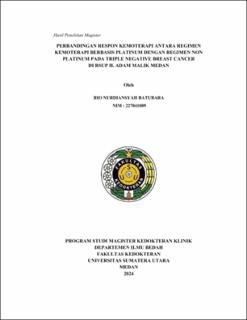| dc.description.abstract | Background: Triple Negative Breast Cancer (TNBC) is a distinct and aggressive breast cancer subtype that lacks estrogen, progesterone, and HER2 receptors, making it challenging to treat. Chemotherapy remains the cornerstone of TNBC management, with platinum-based and non-platinum regimens commonly used. Comparative data on the effectiveness of these regimens in TNBC patients is limited.
Objective: This study aims to compare the chemotherapy response between platinum-based and non-platinum regimens in patients with triple negative breast cancer at H. Adam Malik General Hospital, Medan.
Methods: This observational analytic study employed a retrospective cohort design including 60 TNBC patients treated at H. Adam Malik General Hospital, Medan. Patients were divided into two groups: 30 received platinum-based regimens and 30 received non-platinum regimens. Chemotherapy response was assessed based on RECIST criteria, categorizing outcomes as complete response (CR), partial response (PR), stable disease (SD), or progressive disease (PD). Statistical analysis was performed to compare response rates between the two groups.
Results: A significant difference was found in complete response (CR) and stable disease (SD) rates between the two regimens. Platinum-based regimens were more effective in achieving CR (33.3%), while non-platinum regimens were more frequently associated with SD (23.3%). No significant differences were observed in partial response (PR) and progressive disease (PD) rates.
Most TNBC patients at H. Adam Malik General Hospital were in the 40–60 year age group (66.7%), with a mean age of 45.3 ± 8.9 years. All patients were female, and the most common histological subtype was Invasive Ductal Carcinoma (83.3%).Patients receiving platinum-based regimens showed the following response distribution: CR 33.3%, PR 53.3%, SD 6.6%, and PD 6.6%. In the non-platinum group: CR 16.7%, PR 40%, SD 23.3%, and PD 20%
Conclusion: Platinum-based chemotherapy regimens provide a significantly better complete response compared to non-platinum regimens in TNBC patients, while non-platinum regimens are more likely to result in stable disease. These findings support the use of platinum-based regimens as a preferred option in this population, with ongoing monitoring for toxicity.
Keyword: triple negative breast cancer, chemotherapy, platinum-based regimen, non-platinum regimen, response, clinical outcome | en_US |


